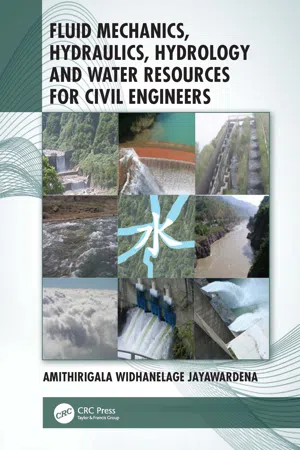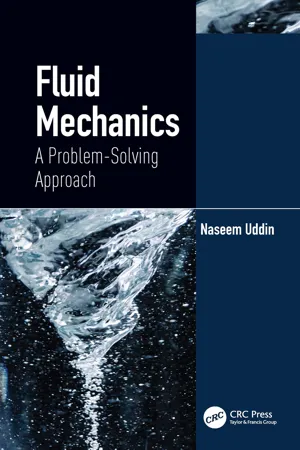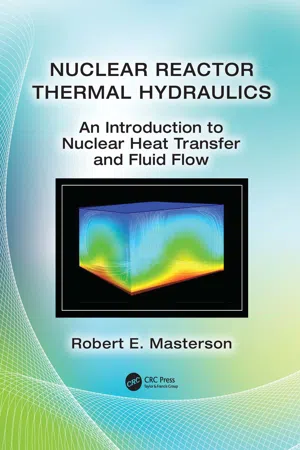Technology & Engineering
Laminar vs Turbulent Flow
Laminar flow refers to smooth, orderly movement of fluid particles in parallel layers, with minimal mixing between layers. Turbulent flow, on the other hand, is characterized by chaotic, irregular movement with mixing and eddying of fluid particles. The distinction between laminar and turbulent flow is important in engineering and technology, particularly in the design and operation of fluid systems.
Written by Perlego with AI-assistance
5 Key excerpts on "Laminar vs Turbulent Flow"
- Amithirigala Widhanelage Jayawardena(Author)
- 2021(Publication Date)
- CRC Press(Publisher)
Chapter 14 Turbulence14.1 Introduction
In the context of fluid mechanics, there are several definitions of turbulence but none quite precise. The earliest definition is perhaps after Osborne Reynolds (1883), who described it as a kind of ‘sinuous motionʼ. Subsequently, Taylor (1937) and von Kármán (1937) defined it as ‘Turbulence is an irregular motion which in general makes its appearance in fluids, gaseous or liquid, when they flow past solid surfaces or even when neighbouring streams of the same fluid flow past or over one anotherʼ. In the book by Hinze (1959), he defines it as ‘Turbulent fluid motion is an irregular condition of flow in which the various quantities show a random variation with time and space coordinates, so that statistically distinct average values can be discernedʼ. Some characteristics of turbulence include three-dimensional unsteady behaviour, disorder, chaotic, seemingly random but deterministic, non-repeatability, sensitive to initial conditions, extremely large range of space and time scales, and enhanced mixing and dissipation.Almost all types of flows in nature are turbulent, some to a lesser degree than others. Laminar flows occur in rare, controlled conditions only. Turbulent flow in nature include the mixing of milk when stirred in a coffee cup, blood flow in arteries due to complexity of geometry and pulsatality of the flow, flow around a wall in a channel, boundary layer, rotation and vorticity, smoke coming out of a chimney, waves, flow of a fluid around an object, and, motion of an object such as an automobile, train, ship, airplane, rocket etc. in a fluid (liquid and/or gas). In large scale systems, such as in storms and cyclones, the Coriolis force needs to be considered. The dissipation of energy is characterized by the diffusion and mixing of mass (matter), momentum, and energy at a rapid rate compared to laminar flows. The physical complexity of the problem increases when the effects of compressibility and combustion are taken into consideration, and in multi-phase analysis. Turbulence is an area of fluid mechanics which is not fully understood at the present time, but useful analysis and predictions can still be made using physical intuition, dimensional analysis, numerical techniques and empirical methods. Turbulence, though seemingly random, is fully deterministic and obeys the laws of conservation of mass, momentum and energy and hence the Navier−Stokes equations. The dependent variables involved in fluid mechanics include velocities, pressures, and temperatures which appear to fluctuate with the independent variables in space and time. Such fluctuations can be irregular, chaotic and usually unpredictable. The dependent variables in turbulent flow are usually represented as the sum of a mean value and a fluctuating component and their variations are expressed in terms of statistical parameters (or moments) such as the variance, kurtosis, etc. Turbulent flow is necessarily non-linear with Reynolds numbers (or other similar dimensionless numbers) exceeding critical values.- eBook - ePub
Fluid Mechanics
A Problem-Solving Approach
- Naseem Uddin(Author)
- 2022(Publication Date)
- CRC Press(Publisher)
9 Introduction to Turbulent FlowsDOI: 10.1201/9781003315117-9Turbulent flows are desirable in engineering applications as they help in increased momentum and thermal diffusion. Understanding and control of turbulence is important as we can estimate turbulence related drag.■■■■■■Learning outcomes: After finishing this chapter, you should be able to:- Define the turbulent flow.
- Understand differences between laminar and turbulent velocity profiles and plot the turbulent velocity distributions in dimensionless coordinates.
- Understand the turbulent eddy scales and secondary flows.
- Understand the difference between three major turbulence simulation approaches.
In many industrial and engineering applications, turbulent boundary layers are more frequent than the laminar flows. The significant contribution in drag on boats, planes, and cars comes from turbulence, and thus the understanding turbulence is crucial for energy-efficient transportation involving less fuel consumption. The atmosphere and oceans also have turbulent flows; thus, it has an enormous contribution in shaping the planet's climate. A slight increase in air turbulence may cause a significant rise in the cost of a flight over the Atlantic Ocean.9.1 WHAT IS TURBULENCE?
Turbulence is a three-dimensional time-dependent motion in which vortex stretching causes velocity fluctuations. Turbulence is one of the most complex phenomena in nature. Some of the reasons for the complexity are:- Intrinsic spatio-temporal randomness:
- eBook - ePub
- David Ting(Author)
- 2016(Publication Date)
- Academic Press(Publisher)
At this point we are quite comfortable with the general notions of laminar and turbulent flows. For laminar flows, the adjacent layers of fluid slide past one another in a smooth, orderly manner. The mixing is due to molecular diffusion. In turbulent flows, eddies move randomly in all directions, crossing adjacent fluid layers and significantly enhancing mixing.The flows in most practical combustion devices are turbulent. Furthermore, turbulence is often designedly created and/or enhanced in order to augment the mass-burning rate. This increase in the chemical energy release rates in turn boost the power output. For example, as the speed (rpm) of an internal combustion engine is increased, the turbulence intensity increases, and thus the mass burning rate. For this reason, parameters such as spark timing do not have to be drastically altered as the engine speed changes.What is turbulent combustion? It is somewhat difficult to provide a definite, rigorous answer to this. Nonetheless, in a general sense, we may view turbulent combustion simply as combustion characterized by turbulent flow. By the same token, laminar combustion is combustion, which takes place in a laminar environment. We are going to focus only on premixed flames in which the fuel and the oxidizer are well-mixed prior to ignition. Before going further, let us brief ourselves with some of the basic terminologies involved. Keep in mind that the purpose of this chapter is to illustrate flow turbulence in applications.10.1.1. Premixed Laminar Flame
For a premixed laminar flame, it is possible to define a flame velocity that, within reasonable limits, is independent of the experimental apparatus. In other words, the laminar flame speed or laminar burning velocity depends only on the fuel, oxidizer, and transport properties such as thermal conductivity, viscosity, and molecular diffusivity. We will see that to define a turbulent flame velocity in such a rigorous manner is not possible. - eBook - ePub
Nuclear Reactor Thermal Hydraulics
An Introduction to Nuclear Heat Transfer and Fluid Flow
- Robert E. Masterson(Author)
- 2019(Publication Date)
- CRC Press(Publisher)
enclosed flows .FIGURE 17.3 Newtonian fluids are fluids that exhibit a linear relationship between the velocity gradient and the shear stress. Almost all reactor coolants are Newtonian in nature. The rate of deformation of a Newtonian fluid (the velocity gradient) is proportional to the shear stress, and the constant of proportionality is the viscosity μ.FIGURE 17.4 When a flow field is laminar, the streamlines flow over each other in orderly layers and do not intermix. The Reynolds number for these flows is low. This is true for both waterfalls and aircraft wings. Laminar flows can also occur in reactor coolant channels when the coolant pumps are turned off. However, in most cases, the coolant flow in a reactor core is highly turbulent. The picture on the right is a numerical simulation performed by NASA.17.5 Characteristics of Turbulent Flows
In turbulent flows, small turbulent eddies appear in the flow field, and the streamlines disappear. These turbulent eddies are superimposed on the overall direction of the flow. The flow becomes chaotic, and these eddies can spin in different directions at different speeds. As the velocity of the coolant increases, more of these turbulent eddies appear. When this occurs two fluid molecules passing the same point in the flow will follow different paths. The entropy or the molecular disorder of the flow field becomes very high. In the center of a reactor coolant channel, the coolant develops what is called a turbulent core . Within the turbulent core, the average velocity of the coolant is relatively uniform, and unlike laminar flows, the velocity profile is no longer parabolic in shape. However, even when the flow is turbulent, there is a laminar sublayer close to the surface of the fuel rods. This laminar layer creates a large velocity gradient du/dy next to the rods, and this velocity gradient increases the wall shear stress τ. The degree of mixing is fairly uniform within the turbulent core. This causes turbulent flows to have much higher convective heat transfer coefficients than laminar flows - eBook - ePub
- James Patrick Abulencia, Louis Theodore(Authors)
- 2011(Publication Date)
- Wiley-AIChE(Publisher)
PART III FLUID FLOW CLASSIFICATIONThis part of the book is concerned with Fluid Flow Classification. It contains five chapters and each serves a unique purpose in an attempt to treat nearly all important aspects of fluid motion. From a practical point-of-view, many systems and plants involve the movement of liquids and gases from one point to another; hence, the student and/or practicing engineer is concerned with several key topics in this area including:All receive some measure of treatment in the material contained in this part.1. Chapter 12: Fluid Flow Mechanisms2. Chapter 13: Laminar Flow3. Chapter 14: Turbulent Flow4. Chapter 15: Compressible and Sonic Flow5. Chapter 16: Two-Phase FlowPassage contains an image CHAPTER 12 FLOW MECHANISMS 12.1 INTRODUCTION
When fluids move through a closed conduit of any cross-section, one of two different types of flow may occur. These two flow types are most easily visualized by referring to a classic experiment first performed by Osborne Reynolds in 1883. In Reynolds’ experiment, a glass tube was connected to a reservoir of water in such a way that the velocity of the water flowing through the tube could be varied. A nozzle was inserted in the inlet end of the tube through which a fine stream of colored dye could be introduced.Reynolds found that when the velocity of the water was low, the “thread” of dye color maintained itself throughout the tube. By locating the nozzle at different points in the cross-section, it was shown that there was no mixing of the dye with water and that the dye flowed in parallel, straight lines.At high velocities, it was found that the “line” or “thread” of dye disappeared and the entire mass of flowing water was uniformly colored with the dye. In other words, the liquid, instead of flowing in an orderly manner parallel to the long axis of the tube, was now flowing in an erratic manner and so there was complete mixing.
Index pages curate the most relevant extracts from our library of academic textbooks. They’ve been created using an in-house natural language model (NLM), each adding context and meaning to key research topics.
Explore more topic indexes
Explore more topic indexes
1 of 6
Explore more topic indexes
1 of 4




